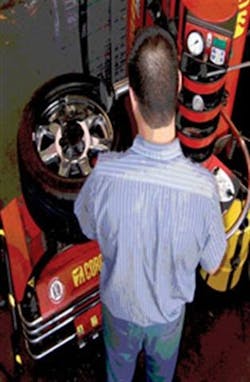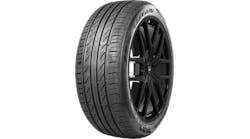It may sound overly simplistic, but an independent tire dealership's success in the high performance tire retail market ultimately depends upon two things: correct tire/wheel mounting and correct tire/wheel balancing.
"How many times do you get a second chance with a customer?" says Dan DeLoss, director of sales and marketing for McCourt Industries, which sells Corghi tire changers and balancers.
Knowing and practicing correct mounting and balancing techniques will satisfy finicky high performance tire and wheel buyers.
Here's a look at 10 of the most common high performance tire mounting and balancing mistakes. The first five deal with mounting tires.
[PAGEBREAK]
1. Mounting mistake: Failure to recognize tire pressure monitoring systems, run-flats and other special technologies.
"Is the vehicle equipped with a tire pressure monitoring system (TPMS)?" asks Michael Alusick, worldwide product manager, undercar products, for Snap-On Equipment, which sells John Bean and Hoffman brand tire machines.
"You have to pay attention to what type of TPMS is on the vehicle. If the sensor is at the valve, it has the potential to be damaged."
Make an official notation that TPMS sensors are working before you service any vehicle.
This will protect you from customer accusations that you damaged their tire pressure monitoring systems during mounting or demounting, says Dave Scribner, product manager for Hunter Engineering Co.
2. Mounting mistake: Improper handling of reverse mount wheels.
Reverse mount wheels are becoming extremely common, according to DeLoss. "For example, Toyota has some reverse mounts at OE."
He recommends using a reverse mount adaptor to avoid scratching the wheel's surface. "Scratches on a chrome rim turn into rust."
When clamping, use jaw protection to avoid damage. "Most tire changers will give you specs for outside clamping," says Alusick.
[PAGEBREAK]
3. Mounting mistake: Inserting the bead breaker the wrong way.
If you don't insert the bead breaker closely enough, you run the risk of damaging sidewall plies. Wheels also can be damaged by an incorrectly inserted bead breaker.
4. Mounting mistake: Not using the proper amount of lubrication.
Lube should be used both when the tire is mounted and when it's removed.
"Too much lube or incorrect mixtures with excessive water can cause tire-to-wheel slippage and vibration problems," says Scribner. "Too little or no lube can cause damage to the tire and wheel."
In addition, using incorrect lubricants can create long-term wheel corrosion, leakage and premature failures.
Make sure you lube the inner toe area of the tire bead, the bead seat and the balcony of the wheel drop center.
5. Mounting mistake: Holding the bead in the drop center by using hand-held bars.
"If the bar slips and the tire comes up, you're going to rip the tire bead," says Fred Ison, a McCourt trainer. You also may damage the rim.
"You may get away with (using bars) 100 times in a row, but that 101st time when you damage a $2,000 wheel negates all of that."
Techs also can be hurt if a bar suddenly breaks loose. Use a mechanical or pneumatic assist to hold the tire into the drop center while mounting the upper bead, says Alusick.
"With most changers, you can place the bottom bead on the rim without difficulty. But you must get the upper bead into the drop center of the wheel without damaging the tire and rim.
"As we get into 30- and 40-series tires, sidewalls are fairly stiff, so it's difficult -- if not impossible -- for a tech to drop that bead using only hand pressure."
"Take your time when mounting," says Kevin Keefe, director of marketing for Hennessy Industries Inc. "I can't emphasize this enough. Take all the proper precautions. Don't skip any steps.
"You should be following standard practices already, but standard practices are all the more important with low-profile, stiff sidewall tires."
[PAGEBREAK]
Balancing errors
Balancing tire and wheel assemblies requires more care than ever due to the increasing complexity of vehicles, says Keefe. "Vehicles have gotten lighter and suspensions have gotten stiffer. You have to pay attention to the basics."
Here are five common balancing mistakes:
1. Balancing mistake: Outside coning.
The use of outside cones can lead to wobbling and run-out, according to McCourt Industries' DeLoss.
He recommends placing a cone on the back of the assembly and then applying the correct-size plate by centering it on the lug holes.
The idea is to make sure you have mounted and centered the assembly in the same manner it will be mounted and balanced on the vehicle, explains Keefe.
"The cone provides centering, and a pin plate will exert clamping force on the lug holes on the wheel in the same manner in which the wheel will feel clamping force when it's back on the car."
Most aftermarket rims, on the other hand, are lug-centric, he notes. With lug-centric wheels, "you still use the cone and pin plate on the outside. Again, you have replicated the mounting condition it will see on the vehicle. This will solve 60% of vibration issues."
[PAGEBREAK]
2. Balancing mistake: leaving residual static imbalance.
Residual static imbalance is the amount of balance left in the assembly when you have dynamically balanced the assembly to zero, says Keefe.
"You can end up with a maximum of a half-ounce of residual static. A half-ounce will bring a lot of vehicles back to your shop." Get rid of residual imbalance by adjusting wheel weights.
3. Balancing mistake: using second-hand wheel weights.
Once a steel clip has been used, it no longer has the retentive capabilities of a new clip.
Used clips come loose and fall off. "If you lose a weight, you'll get vibration," says Keefe.
4. Balancing mistake: ineffectively reducing radial run-out.
"How round is that assembly?" asks Keefe. An out-of-round condition "will mimic static vibration."
He recommends re-positioning wheel weights to reduce run-out. "In some instances, a wheel with run-out can be re-mediated by putting the high spot of the tire over the low spot of the wheel."
5. Balancing mistake: incorrect mounting after the assembly has been balanced.
"Once the assembly is off the balancer, you still have another major opportunity for error: putting the assembly back on the wheel," explains Keefe.
[PAGEBREAK]
"It's absolutely imperative to torque the assembly to manufacturers' specs. Variance in lug nut torque is a major cause of vibration. If you use consistent torque, it eliminates one of the variables that can cause a comeback."
It also bears repeating that proper maintenance of equipment is critical to correct mounting and balancing, says Hunter Engineering's Scribner.
"Tire changers use high mechanical force when changing tires. Periodically check machines for loose hardware and calibration."
And before you mount or balance anything, note pre-existing tire and wheel conditions "to be sure that any cosmetic damage, missing hardware and broken studs are not blamed on the shop who has received the vehicle for service."



